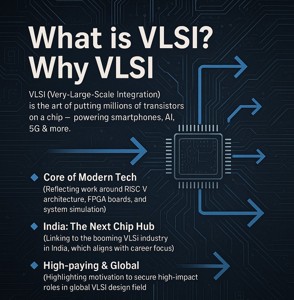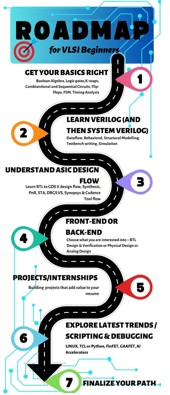
What is VLSI? Why VLSI? A Clear Roadmap for Freshers
What is VLSI? Why VLSI? A Clear Roadmap for Freshers
Let’s be honest — when I first heard the term VLSI, I thought it sounded like some alien technology or a secret code only scientists understood. Turns out, it’s not only understandable, but also one of the most exciting fields in electronics and computer engineering today. So, if you’re a student, a fresher, or even someone switching lanes, this post is for you.
So... What is VLSI?
VLSI stands for Very-Large-Scale Integration. Still sounds complex? Here’s the simplest way to look at it:
It's the art and science of putting millions (or billions) of transistors on a tiny silicon chip to create powerful integrated circuits.
That tiny chip in your smartphone? Your laptop processor? Your smartwatch, your Wi-Fi router, even your washing machine? Yep — all of them use VLSI-designed chips.
It’s like building an entire city on a silicon wafer — with roads (wires), buildings (logic gates), traffic rules (protocols), and a brain (control logic) — all designed with nanometre-level precision.
Why VLSI?
This is the million-dollar question. Why should you care about VLSI? Let me break it down simply:
1. It’s the Core of Modern Tech
From AI to autonomous cars, from 5G to smart wearables — everything runs on chips. And someone must design and verify those chips. That’s us — VLSI engineers.
2. India is Becoming a Chip Hub
With government initiatives like Semicon India, PLI schemes, and massive investments in fabs and startups, VLSI is booming in India like never before.
3. It Pays Well (and Deservedly So)
VLSI jobs demand deep skill, but they also reward you with great pay, strong growth, and international opportunities. Unlike saturated software jobs, VLSI is still niche — and in demand.
4. You're Not Just Writing Code
You’re in fact designing hardware that billions of people might use. There’s something deeply satisfying about seeing your design etched in silicon.
Roadmap for Freshers — How Do You Get Into VLSI?
If you’re starting from scratch, here’s a step-by-step guide I wish someone gave me earlier. Save this list.
Step 1: Get Your Basics Right
Start with the fundamentals. If your digital electronics concepts are shaky, everything else will collapse later.
• Boolean algebra, logic gates, K-maps
• Combinational and sequential circuits
• Flip-flops, FSMs, timing diagrams
????Recommended Book: Morris Mano – Digital Design
Step 2: Learn Verilog (and Then System Verilog)
No VLSI without HDL. Start with Verilog — learn how to describe hardware, simulate designs, and write testbenches.
• Dataflow, Behavioural, and Structural modelling
• FSMs in Verilog
• Testbench writing and simulation with tools like ModelSim or VCS
Tip: Simulate your code early. Seeing the waveforms makes everything click.
Step 3: Understand the ASIC Design Flow
You don’t need to know everything at once — just know how RTL goes to GDSII.
• Synthesis (Design Compiler, Genus)
• Place & Route (ICC, Innovus)
• Static Timing Analysis (PrimeTime)
• DRC/LVS/Physical Verification
Get familiar with Synopsys and Cadence tools. Internships help a lot here.
Step 4: Know What You Like — Front-End or Back-End?
• Front-end deals with RTL Coding, Simulation, Verification.
• Back-end is physical design — Floorplanning, Routing, Clock Tree Synthesis.
Both have massive scope. Try both — see what excites you more.
Step 5: Projects, Internships, and GitHub
Theory is great — but recruiters love projects. Here’s what you can build:
• UART/SPI/I2C controllers in Verilog
• 8-bit ALU with testbench
• FSM for elevator/lift control
• Synthesis + STA of any simple RTL block
Show your work. Document it. Upload to GitHub. Write LinkedIn posts about it. Make noise.
Step 6: Learn Linux, Scripting & Debugging
You can’t survive in VLSI without some Bash, TCL, or Python scripting. You’ll need them for automation and tool interaction.
Also, learn to read logs. Half the job is about debugging broken runs.
Step 7: Explore Latest Trends
Once you’re comfortable, peek into:
• FinFET, GAAFET, CFET
• High-speed designs,
• Low-power techniques
• AI accelerators and Chiplets
This isn’t urgent, but it makes you stand out in interviews.
Final Words: VLSI is Not Just a Career. It’s a Craft.
VLSI is not a “trend” — it’s the foundation of the digital age. But it’s not for everyone. It requires patience, precision, and passion. If you’re someone who likes solving puzzles, working in nanometres, and building something real — VLSI is for you.
And hey, don’t let the complexity scare you. Everyone starts somewhere. And every VLSI engineer was once a confused fresher asking, “What is VLSI?”
If you’ve read this far, you’ve already taken the first step.
“You don’t have to see the whole chip to start building the first gate. Just begin — the rest will come layer by layer.”
Written by
Priyanka C
Application Engineer
Ramaiah Skill Academy
